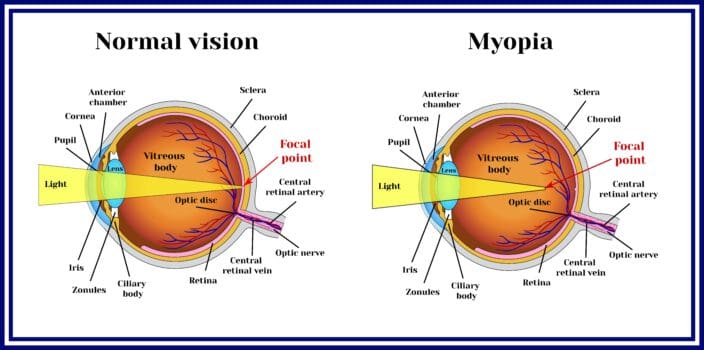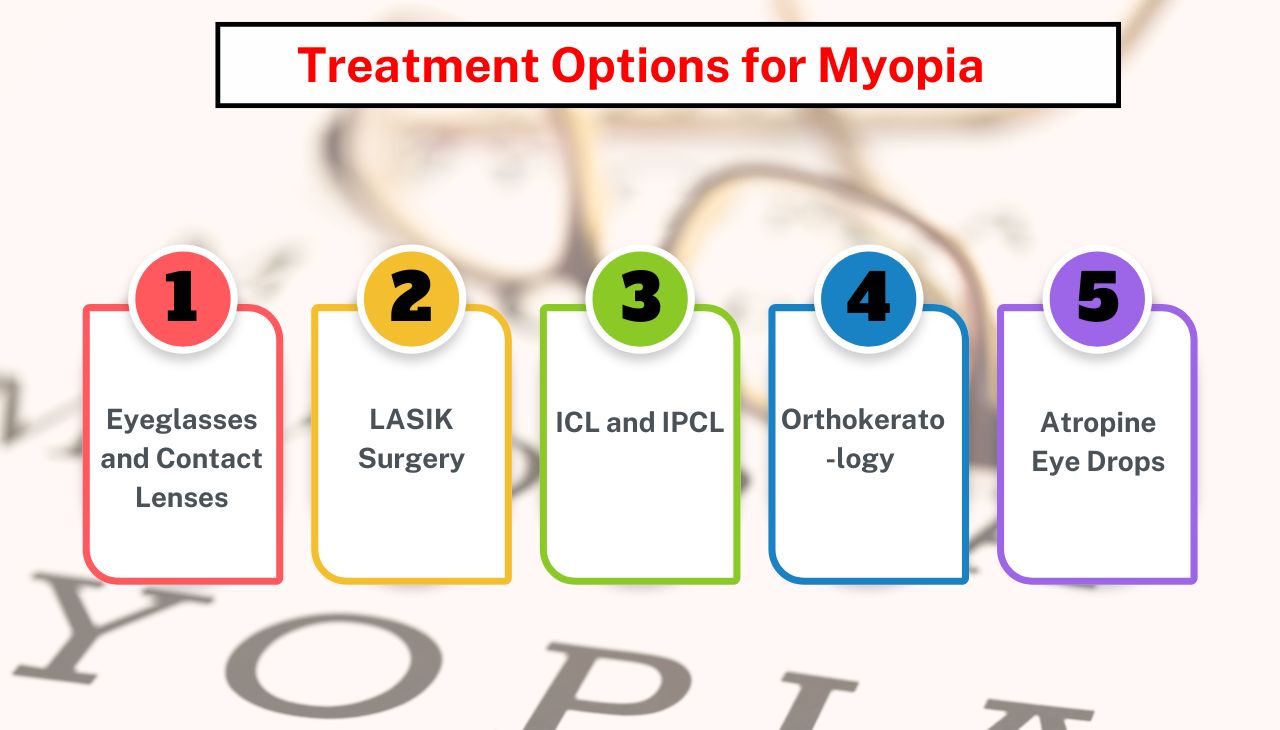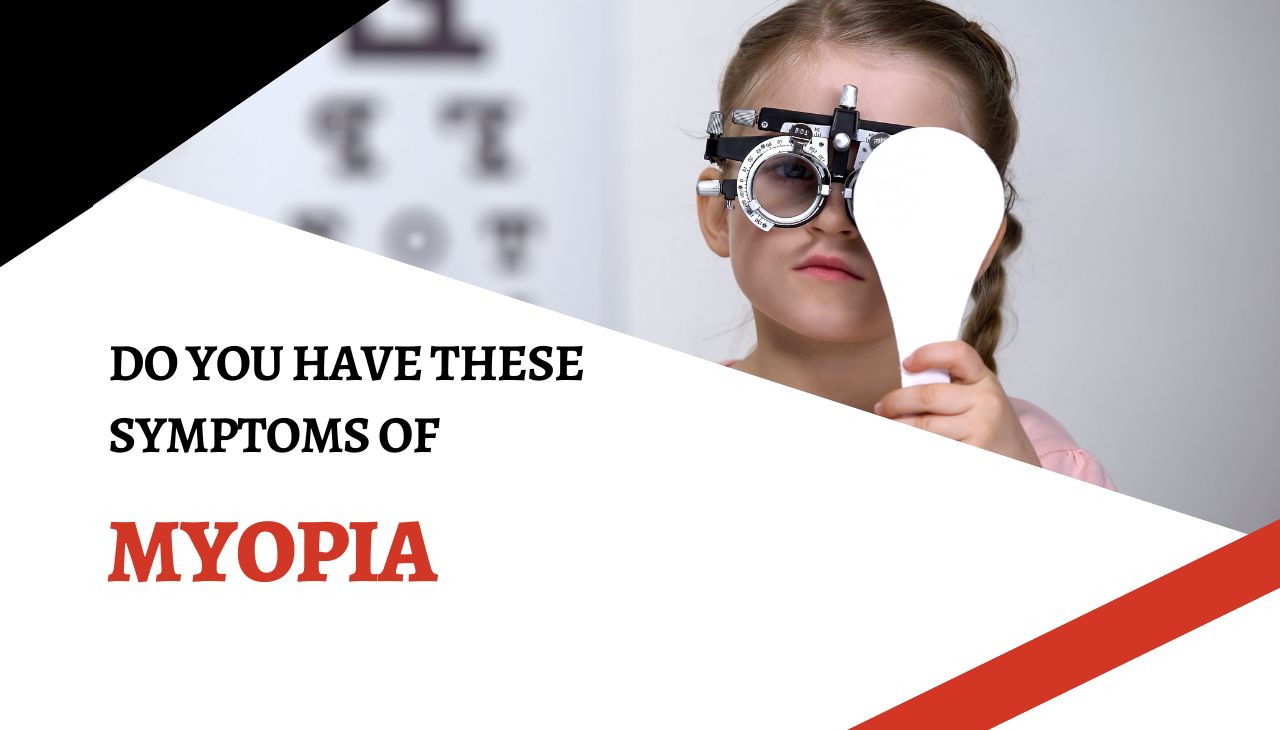Myopia, also known as nearsightedness, is a common refractive error of the eye where distant objects appear blurry while nearby objects remain clear. It is one of the most widespread vision problems across the globe, affecting people of all ages. The key to managing myopia lies in recognizing its symptoms early, allowing individuals to seek the appropriate treatment before the condition worsens. This blog will help you identify the symptoms of myopia and explore treatment options available at Laxmi Eye Institute, a trusted name in eye care.
Types of Myopia

- Simple Myopia (Axial Myopia)
- The most common form of Symptoms of Myopia, often seen in children and young adults. It occurs when the eyeball is too long, causing light to focus in front of the retina. This type typically stabilizes after the individual reaches adulthood.
- Pathological Myopia (Degenerative Myopia)
- A severe, progressive form of myopia, often associated with an abnormal elongation of the eyeball. It can lead to complications like retinal thinning, macular degeneration, cataracts, and glaucoma. This type tends to worsen over time.
- High Myopia
- This refers to a more advanced level of myopia, typically greater than -6.00 diopters. People with high myopia experience significant vision impairment and are at higher risk of developing serious eye conditions like retinal detachment.
- Congenital Myopia
- A rare form of myopia that is present at birth or develops in early childhood. It is usually caused by genetic factors and may require early intervention for vision correction.
- Progressive Myopia
- Symptoms of Myopia that continues to worsen over time, often starting in childhood and continuing into adulthood. It requires regular monitoring and corrective measures to manage the condition effectively.
Symptoms of Myopia
Myopia is characterized by the inability to focus on distant objects, but its effects extend beyond just blurry vision. Here are the most common signs:
- Blurred Distant Vision: The most noticeable symptom of myopia is difficulty seeing objects clearly at a distance. You might struggle to see things like road signs, the board in a classroom, or the TV from across the room.
- Squinting: To compensate for blurry vision, individuals with myopia often squint. This temporary measure may help improve focus but does not address the root cause of the problem.
- Frequent Headaches: Myopic individuals often experience headaches, particularly after trying to focus on distant objects for prolonged periods. This is a result of eye strain from constantly working hard to focus.
- Eye Strain and Fatigue: People with myopia tend to experience discomfort in their eyes, especially after reading, watching TV, or using screens for long durations. This strain often leads to fatigue and discomfort.
- Difficulty Seeing at Night (Night Myopia): Myopia tends to worsen in low-light conditions. Individuals with this condition may experience more difficulty with glare, halos around lights, and a general reduction in visual clarity during the night.
- Frequent Changes in Prescription: If your glasses or contact lenses prescription changes frequently, it could be a sign that your myopia is progressing. Children and young adults are particularly susceptible to this.
- Poor Performance in School or Work: If you find yourself or your child having difficulty reading or seeing distant objects clearly during work or study sessions, it could indicate myopia. Poor academic performance may also stem from this issue if visual problems are left uncorrected.
Causes of Myopia

Understanding the causes of myopia is important in addressing it. Here are some factors that contribute to the development of this condition:
- Genetics: Myopia tends to run in families, and children of myopic parents are more likely to develop the condition.
- Excessive Near Work: Spending long hours on activities like reading, writing, or using electronic devices can increase the risk of myopia, particularly in children.
- Environmental Factors: Growing evidence suggests that lack of time spent outdoors and exposure to natural light may contribute to the development of myopia.
- Eye Structure: In myopia, the eyeball is typically longer than normal, or the cornea is too curved. This causes light entering the eye to focus in front of the retina, resulting in blurred vision.
Why Myopia Matters
If left unaddressed, myopia can lead to further vision complications, including increased risk of glaucoma, cataracts, and retinal problems. Early intervention can not only correct the vision but also slow down its progression, ensuring better long-term eye health.
Treatment Options for Myopia
There are several treatments available to manage myopia, ranging from corrective lenses to surgical options. Some of the most common treatments include:

- Eyeglasses and Contact Lenses: These are the most common ways to correct myopia. Eyeglasses or contacts help focus light directly onto the retina, providing clear vision.
- LASIK Surgery: LASIK (Laser-Assisted in Situ Keratomileusis) is a popular surgical option that reshapes the cornea to correct the focusing error. It is a safe and effective procedure for those who are suitable candidates.
- Implantable Contact Lenses (ICL and IPCL): For those who are not candidates for LASIK, implantable lenses can be surgically inserted into the eye to correct myopia. This is a permanent solution that eliminates the need for glasses or contact lenses.
- Orthokeratology (Ortho-K): Special contact lenses are worn overnight to reshape the cornea temporarily. This provides clear vision during the day without the need for glasses or contact lenses.
- Atropine Eye Drops: Low-dose atropine eye drops may be prescribed for children to slow the progression of myopia. This treatment has been shown to be effective in some cases.
Why Choose Laxmi Eye Institute for Myopia Treatment?
Laxmi Eye Institute, one of the largest chains of eye hospitals in Mumbai, has been providing top-tier eye care for over 30 years. Known for its highly experienced team of doctors and transparent treatment methods, Laxmi Eye offers comprehensive services for myopia treatment, including advanced diagnostic tools and surgical options like LASIK and ICL.
Our clinics are located at:
- Laxmi Eye Clinic (Dombivli)
1st Floor, Laxmi Eye Institute, SS Business Park, Gharda Circle, Azde Gaon, Tata Power Company Limited, Dombivli East, Mumbai, Maharashtra 421201 - Laxmi Eye Clinic (Kharghar)
Office 108, 109 and 110, 1st Floor, Anant CHS Plot 31, Sector 04, Kharghar, Navi Mumbai, Maharashtra 410210 - Laxmi Eye Hospital & Institute (Panvel)
Mulla Hamid Rd, Old Panvel, Panvel, Navi Mumbai, Maharashtra 410206 - Laxmi Eye Institute (Kamothe)
Shop No 26/27, Near ICICI Bank, Kamothe, Navi Mumbai, Maharashtra 410209, India
To book an appointment or to consult our experts, you can reach us through our website or by calling the nearest clinic. Our dedicated team is here to help you find the right treatment for your eye condition.
Frequently Asked Questions (FAQs)
- What causes myopia?
Myopia is caused by a mismatch between the shape of the eye and the way light enters it. It is usually hereditary, but environmental factors like excessive near work also contribute. - Can myopia be cured?
While myopia cannot be permanently cured, it can be managed effectively through corrective lenses, LASIK surgery, or implantable lenses. - Is LASIK surgery safe for myopia?
LASIK surgery is a safe and effective treatment for myopia. However, it’s important to consult with an experienced eye surgeon to see if you’re a suitable candidate for the procedure. - At what age does myopia develop?
Myopia typically develops during childhood and may worsen in the teenage years. It can also occur in adulthood, especially with extensive near work. - How can I prevent myopia from worsening?
Regular eye checkups, reducing screen time, spending time outdoors in natural light, and using corrective lenses can help manage myopia and slow its progression.
Conclusion
Myopia is a common eye condition that can impact your daily life, but with the right treatment, you can restore clear vision. Whether you need glasses, contact lenses, or surgery, early intervention can prevent further vision loss. Laxmi Eye Institute provides world-class eye care with a focus on patient satisfaction and the latest technology. Don’t wait to improve your vision—book an appointment today and take the first step toward a clearer tomorrow!


